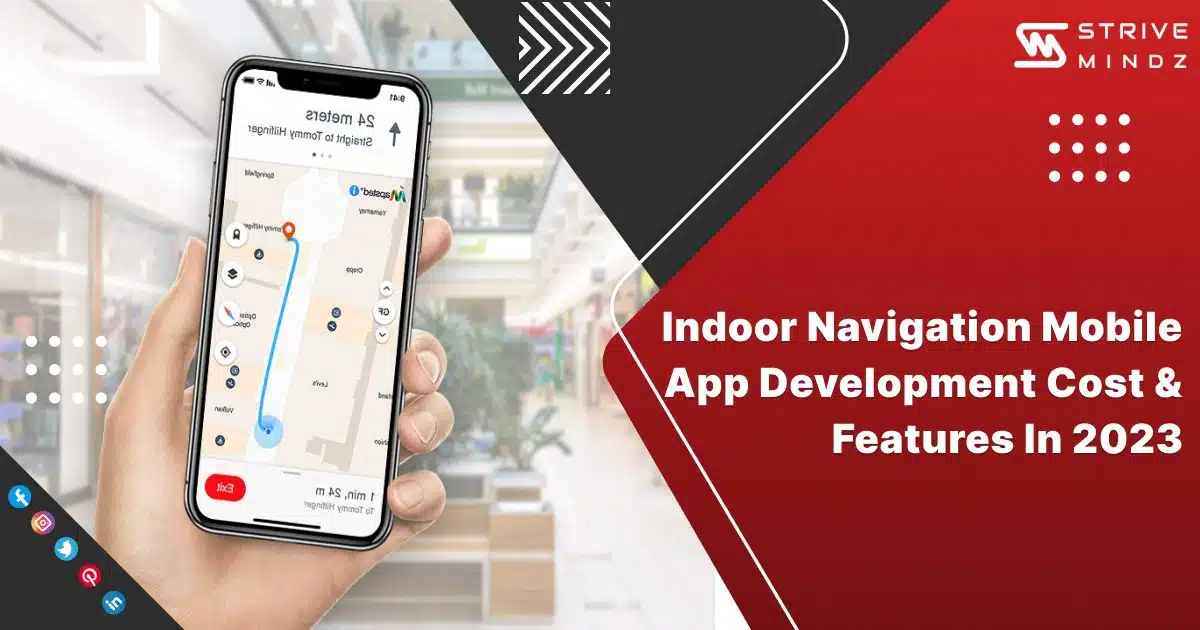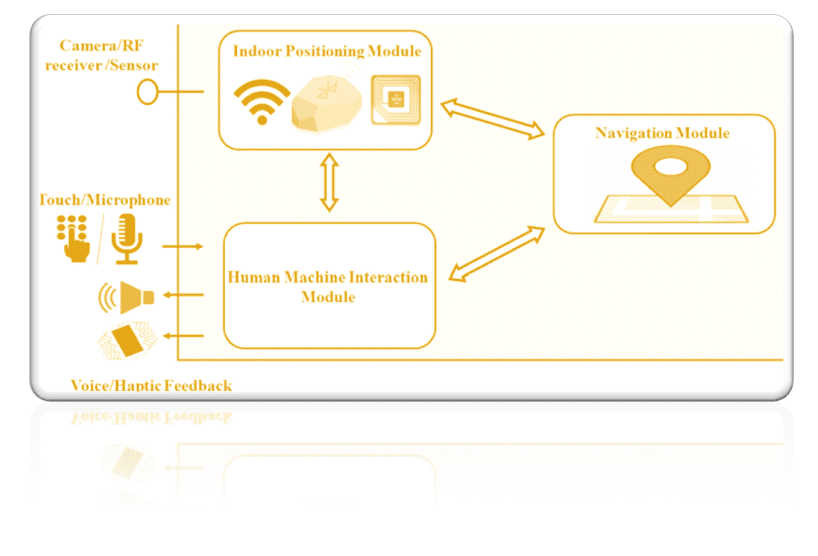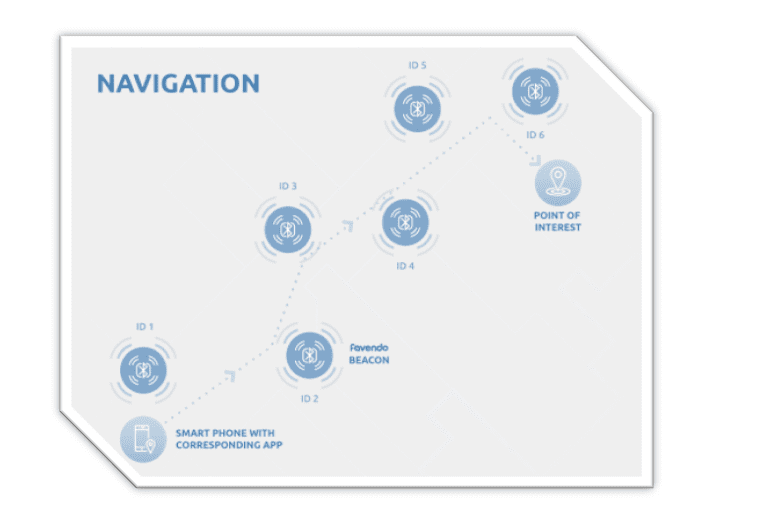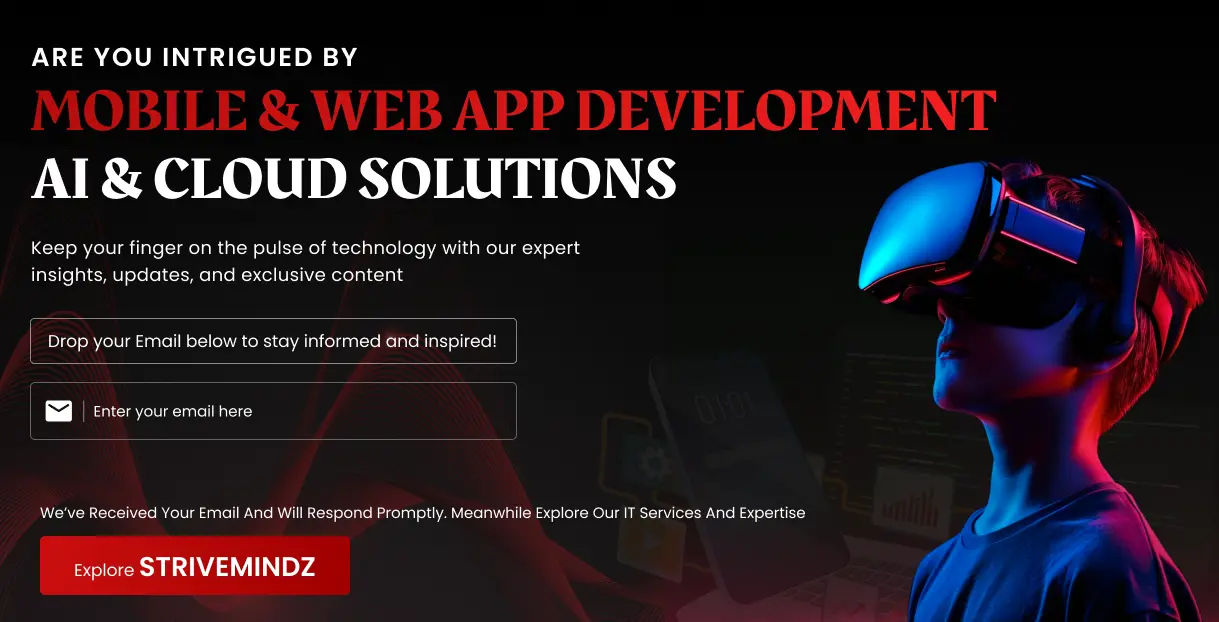Indoor Navigation Mobile App Development Cost & Features in 2023

If you want to travel to a place, you have not visited before or you are not familiar with, then what do you do? The answer is: GPS applications. By using the GPS (Global Positioning System), you can navigate your way through any locality in the world. The GPS is a lifesaver when you are traveling from one place to another.
But what if you were finding a spot in an indoor setting? For example:
- What if you were in a shopping mall and needed to find the location of a specific store?
- What if you were in an airport and needed to find a specific boarding gate?
- How do you find a specific spot when you are navigating your way indoors?
The answer is simple: you need to use the IPS or “Indoor Positioning System”. In this article, you will learn about what exactly IPS does, how to develop an IPS app and how much it is going to cost you. Check out this article to know about the insights related to IPS:
What is The Indoor Positioning System (IPS)?
The GPS depends on satellite signals to help users navigate through the world. However, outdoor navigation cannot work in your indoor crowded campuses because satellite signals do not always work properly.
- Users still require guidance while navigating through large campuses/airports/malls.
- The indoor positioning system helps users to navigate through these indoor spaces. Be it inside airports or hospitals or shopping malls, or other areas, IPS technology helps users quickly navigate through any large campus and reach their destination.
- If you have an IPS app installed on your smartphone, then finding your way through a large commercial place will be easier than ever.
How Do Indoor Navigation Mobile Apps Work?
Just like the GPS system works with the help of satellite signals, IPS technology mainly works with the help of AR technology. The indoor navigation app taps into the built-in internal sensors of your smartphone to find out your exact location within a closed space.
The IPS system uses ultrasound, ultra-wideband, BlueTooth and Wi-Fi signals to extract the exact location data of the device that you are using. To perform efficiently, indoor navigation apps use three major components –
- Underlying the dynamic positioning system platform.
- Serving signals to the positioning system.
- Beaconing broadcast signals received from the device.
These three components combine to point out the exact location of the user in real-time. With the help of sensors such as a gyroscope and accelerometer and signals received from Wi-Fi or Bluetooth, these apps can calculate the exact positioning of the user through complex algorithms.
You can contact the indoor navigation application developers.
Benefits of Using Indoor Navigation Apps
In large commercial places, finding an exact spot can be tricky. Many individuals often find themselves lost while trying to navigate through these large indoor spaces. These indoor navigation mobile apps offer great usability for both businesses and individual users. Especially when you are in a crowded indoor space and you need directions, you can save the hassle of asking strangers for directions. You can simply use your smartphone to point out your exact position in the indoor area and then you can also find your way toward another point in the same indoor space.
These indoor navigation apps offer multiple advantages, which include the following –
- Pointing your positioning with high precision,
- Reliability,
- Cost-effective,
- Maintenance free,
- Offline usability,
- Usable for blind and visually impaired people,
- Easily installable on all smartphones.
Also Read: How Much Does It Cost To Maintain an App
Benefits of Indoor Navigation Mobile Apps for Businesses
The indoor navigation apps allow businesses to offer much better service to their clients. Imagine if you own a large commercial space or a business that has a large campus. You are supposed to get multiple customers and clients each day.
If your clients need to move from one location to another inside your business campus, how are they going to find the accurate spot? By offering them an indoor navigation app that can help them in moving through your campus, you can raise your popularity as a business to new heights. It will be extremely convenient for your clients to have an app that they can use both online and offline or get a map of your facility and follow the map to find different areas in your facility.
Different kinds of businesses and organizations can use these indoor navigation apps to help their clients and customers. Such apps can be used in –
- University campuses,
- Hospitals,
- Hotels and resorts,
- Large apartment complexes,
- Office blocks,
- Shopping malls,
- Stadiums,
- Libraries,
- Museums,
- Transport stations such as bus stations, railway stations, and airports,
- Theme parks, and so on.
Benefits of indoor navigation mobile apps for individual users
Having an indoor navigation app on smartphones can be helpful for these users:
- For a person who is visiting the campus or the facility for the first time, it is made tremendously easy by indoor navigation apps to find different locations inside the compound.
- A real-time map of the facility is provided to the users, which can be accessed both online and offline.
- Voice input and output help users search for an exact location quickly and get accurate results efficiently.
- Users can also use indoor navigation apps to find out the shortest route to their desired destination inside the campus premises.
Some useful features offered by indoor navigation mobile apps
The indoor navigation apps offer the following four major features –
- Map of Facility
- Positioning
- Navigation
- Push notifications
Map of Facility
The indoor navigation apps will provide users with a detailed map of the entire facility or campus, which they can use for further reference. This map can be accessed online and, in most cases, offline as well.
Positioning
The indoor navigation apps can be used to find out the positioning of specific places within the said campus. For example, these apps can be used to find out the location of a specific store inside a shopping mall or a specific department inside a university campus.
Navigation
The name “indoor navigation apps” clearly suggests the main purpose of these apps: indoor navigation. These apps can be used to find out the route to any location inside these facilities or campuses. These apps help users by showing them the shortest possible route to their preferred location.
Push Notifications
The push notifications feature allows users to stay notified about their positioning on a certain campus. This feature also notifies the users when they reach a certain spot on the said campus.
Other than these four features, the indoor navigation apps offer two unique features for businesses as well –
- Visitor’s list
- Send notifications
Visitor’s List
The indoor navigation apps help businesses to track the number of visitors they have each day. This feature helps businesses to collect all the necessary data regarding their visitors, such as – how many times they visit the place. how much time do they spend inside the campus? At which time of the day does the visitor usually come? And so on.
Send Notifications
Once a business has a clearer idea regarding its visitors and their preferences, the indoor navigation app allows the business to notify the visitors about different events and offers. The said business can generate pop-up notifications for visitors with the help of indoor navigation mobile apps.
How to Develop Indoor Navigation Mobile Apps?
Developing your indoor navigation mobile app can be a good strategy to grow your popularity as a business. The first step to developing your indoor navigation app is to hire an indoor navigation mobile app development company.
Strivemindz has been active in the field of mobile app development for quite some time and we understand the importance of your projects. You can always bring your project to us and we will instantly start working to deliver your fully functional indoor navigation app. To develop the indoor navigation mobile app, you would need a team that would consist of:
- A project manager
- UX / UI designers
- Android and iOS developers with experience in ARKit / ARCore
- Back end developers
- Quality assurance manager
To develop your indoor navigation mobile app through Strivemindz, you would have to go through the following steps –
Project planning
Once you meet with the experts at Strivemindz, we will help you in planning your project in detail. Strivemindz considers each aspect of the project and we will make sure that your requirements should meet flawlessly.
It is at this stage that you can decide your final budget, your deadline for the project and the features that you want to include in the app. You will also have an idea regarding the technology that will be used for developing your indoor navigation app.
UX / UI designing
Once the project is planned, we will move on to create the user interface of your project. Our expert UX / UI designers will make your app as attractive as possible for your clients. This step will also be used for wireframing, sketching, mapping, 3D object creation and all other design requirements.
Developing and testing the app
The last step before you can launch your indoor navigation app is the development and testing stage. Our expert developers will work tirelessly to meet your deadlines and once the app is developed, it will go through a testing stage to find out if it is functioning properly. Once we handle the technical issues, such as errors and glitches, you can finally launch the app.
Cost of Developing an Indoor Navigation Mobile App
The cost of developing an indoor navigation app can vary depending on various factors, which include –
- Number of features and functionalities,
- Location of the business,
- The number of platforms for which the app will be compatible, and so on.
The typical price to build your own interior navigation software can be in the range of $25,000 to $30,000. You can hire mobile app developers to develop your indoor mobile applications.
If you want a very basic indoor navigation app without advanced features, you can have your app ready for only around $10,000. For feature-heavy apps, the cost can go as high as $50,000 to $60,000.
After the development of your indoor navigation mobile app, you may need to pay some extra charges for additional services. These include –
- Arbitrary services,
- BLE Beacons,
- Mobile updates,
- Building and maintenance of the server, and so on.
Wrapping up
In this article, we have tried to give you all the necessary information regarding the development of indoor navigation mobile applications. You can get in touch with Strivemindz if you want to create your own indoor navigation app. Contact us for more information.
FAQs
How AR-based indoor navigation should work?
For indoor navigation, the AR designs should be compatible with the real environment. For example: if you are preparing the navigation app for campus then it should include all the campus pictures in a 3D model.
What is the accuracy of the indoor positioning system?
The accuracy of the indoor positioning system depends upon various key factors – such as distance among walls, the accuracy of proximity finders, etc. Although, it is suggested that Bluetooth-based proximity sensors can generate high-accuracy results in the GPS. However, the accuracy can be disturbed within 5 to 10 meters.
What is the use of Radio Frequency Identification (RFID) for indoor positioning systems?
In indoor positioning systems, the use of RFID for detecting items is enabled through RFID sensors. Although, RFID is also used for monitoring ultra-high frequency and super-high frequency methods.
How to make an indoor positioning system with higher accuracy?
You can use Bluetooth-based proximity sensors to improve the accuracy of the indoor positioning system effectively.
What are the benefits of using indoor positioning systems?
There are the following benefits of using an indoor positioning system – such as it will help in improving customer experience, you will gain better data insights, you can conduct data analytics, etc.





